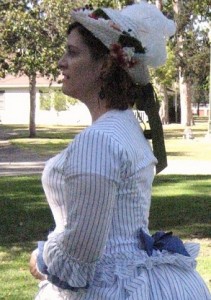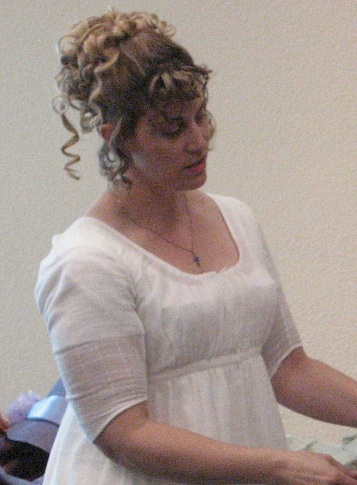
I’ve sewn way too many garments (both historical and modern) where the sleeve was just a little too tight around the upper arm limiting my movement. This is especially frustrating after valuable time was spent adjusting the pattern in the first place.
Wrapping up our Ease-y Does It series for adding Historical Ease to your pattern, let’s look at how to handle too tight sleeves. Even if you have thin arms or toned muscular arms, the ease suggestion applies to you as well.
Getting the proper ease in a tight fitting sleeve can be a struggle. Too loose and the sleeve hangs baggy; too tight and you can’t bend your elbow. And a beautiful 1890s day dress can be spoiled when the wearer can’t lift her tea cup comfortably.
Some historical styles will call for a very tightly fitted long sleeve. This includes Regency through 1840s then again in the late Bustle period and 1890s. Yes – even the leg o’ mutton sleeves of the 1830s and late Victorian have tightly fitted upper arm linings.
I’ve found that if the armhole is cut correctly (close around the arm socket), then the sleeve can be very tight, needing only ½” of ease. Adequate ease and a well-fitted garment go hand-in-hand to achieving the desired silhouette.
Please remember, though, whenever you are making a tight historical sleeve style you take your figure into consideration. A large arm in a too tight sleeve will look like a sausage – no matter what century you’re in. If you carry a lot of weight in the upper arm, use a generous amount of ease. You want the sleeve to be loose over that area but not so loose that it’s baggy and unfitted.

When fitting your sleeve, keep in mind your fashion fabric and underlining. Just as in the bodice, these two layers of costuming materials will “shrink” the circumference of the sleeve.
Sleeve Ease Suggestion:
- 1” to 2” of ease larger than the upper arm circumference measurement
The best way to add ease in sleeves is to first take measurements.
- Measure the fullest area of the bicep – this is generally just below the armpit.
This was my painful learning curve: I have to be careful measuring my upper arm because I’ve discovered when I flex my bicep muscle it produces a larger measure than if I keep my arm down at the side. My Ah-Ha moment arrived when I put it together that “That’s Why!” my sleeves were always a bit tight – my measurement didn’t take in the *movement* of me in the sleeve. It’s not a whole lot larger but even ½” can make a difference in a tight sleeve.

- Measure your pattern. Draw a straight horizontal line between the top edges of the underarm seams. Take out the seam allowance so you have the exact pattern measurement.
- Compare the arm and pattern measurements and add or subtract the ease.
You can add ease to the side seams (equally) but be careful here and don’t add too much. Taper to the elbow or wrist depending on the ease you need to add to those areas.
Another way is to slice the pattern from sleeve cap edge (very top) down to the hem/wrist and open up the top of the pattern to add in the ease. This is the preferred method as it doesn’t change the underarm seam lines.
A couple of modern tricks to use for wearing comfort when making tight fitting sleeves:
- 1. Use a modern stretch cotton fabric for the underlining. You’ll find many of these with 3-8% spandex. You’ll know it when you can stretch the fabric on the grain or cross and it gives a little.
- 2. Cut your underlining fabric (usually cotton, linen or silk) on the bias. This bias lining will move with you and not be binding like the outer fashion fabric sleeve cut on grain.
Have you experienced too tight sleeves? Tell us your story and if and how you solved it.
Miss Parts 1 & 2? Read them here:


I just cut my sleeves on the bias to utilize that stretch…
I needed to help my daughter make a Victorian dress for the Dicken’s Faire where she was performing on flute. She absolutely needed room to move her arms at shoulder level. Gussets were the perfect solution.
I find that if the sleeve is to be tight fitting, cutting on the bias is a great help. I have also put in gussets when I dont have enought to cut on the bias. I am sure it was done in the victorian era.
I have two antique cotton regency gowns that have underarm gussets in their long sleeves. Took me awhile to recognise them, but they are there.
I think Lycra might be the most fantastic invention ever.
Have you ever considered underarm gussets? Perhaps they’re not historically correct.
At a suggestion from a friend who used to make ice skating costumes, I added them to the sleeves of my wedding gown to ensure I could move my arms. The armhole was well fitted so already pretty small. I added a small gusset flap right to the sleeve when I cut it out. While wearing the gown, the gusset tucked neatly into my underarm and made no visible difference. I could move my arms freely and dance to my heart’s content.